Knife Sharpening Systems and Kits
In this article we discuss the pros and cons of selected sharpening systems that all work. They vary only in ease of use, size and price. Sharpening systems can be categorized as follows:
- The blade is held static and the grinding medium is passed over it at the required angle of grind.
- The grinding medium is static and the blade is passed over it at the required angle of grind.
- Electrical sharpeners where the blade is pulled passed a moving grinding belt or disk, which is at the required angle of grind or where the blade is held at the correct angle of grind as it is pulled past a moving grinding belt or disk.
The descriptions are taken from the manufacturer’s literature, but we have tried all these systems and added our own comments.
Manufacturer: D.M.T. The Aligner Guided Diamond Sharpener ensures guided strokes and exact bevels to give a DMT knife sharpener consistent angle and produce the ultimate in fast, accurate knife sharpening. A very flexible guided sharpening system with 7–angle variability and the handle accepts any 10.5 cm (4 inches) DMT® Diamond Whetstone. The knife clamp can be used separately as a sharpening guide with any bench model DMT® Diamond Whetstone. Included is a fabric storage pouch with Velcro enclosure. Price guide £46.00 (around $73). Highly recommended piece of kit.
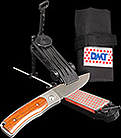
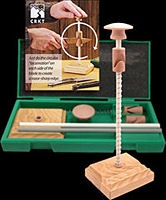
The sharpening action couldn’t be easier. Just pull your blade through a sharpening guide slot pressing down lightly. The return spring pops the guide up again for the next stroke. You then repeat the same action as needed in the opposite slot, sharpening both sides of the blade equally or as needed. Two sharpening guides are included. One is a slight angle for putting an edge on sport, work, tactical and kitchen knives.
The second has a steeper angle for heavier tools such as choppers and machetes. The Slide Sharp system comes with two porcelain sharpening rods. You start with the coarser gray rod and finish the edge with the fine white rod. Price guide around £25.00 ($40). Good but sizable in a 26 x 11.5 cm (10 x 4.5 inches) box.
Manufacturer: Smiths. The Smith’s 3–in–1 Sharpening System is a handy sharpener you can take anywhere Smiths 3 in 1 sharpener and it will do three jobs in one. Features pre–aligned carbides for quick edge setting, 750 grit interrupted surface diamond sharpener and pre–aligned ceramic sharpeners for sharpening standard and serrated blades. The rods easily store in the base. Price guide around £20.00 ($30).
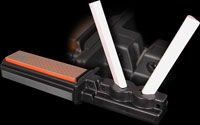
There is also a set of brass safety rods to protect the user’s hand during sharpening. For sharpening plain edges, the flat sides of the stones are ideal. For serrated edges, use the corners. The stones fit into keyed holes and slots molded into the polymer base and have a 40–degree and 30–degree sharpening angle for knives and a 12.5–degree scissor setting.
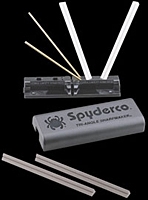
A groove running the length of the stone is for sharpening pointed objects like darts, awls and fish–hooks. All components pack into the base and the lid snaps shut making the 204 self–contained and small enough to carry in your shirt pocket. No lubrication is required during use for dry, mess–free sharpening. Includes instruction DVD and book. Price guide around £50.00 ($80). Good but sharpening is set to give only two possible angles.
Manufacturer: Vulkanus. Vulkanus sharpener A sharpening system that is simple – and really works! This revolutionary design, by Austrian Harald Stallegger, will guarantee a razor sharp edge after only a few swipes. This patented spring–loaded mechanism allows you to pull the blade through the hardened steel inserts along the blade surface, all the way to the tip.
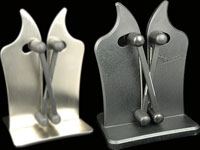
Vulkanus is designed to sharpen serrated blades as well. Price guide around £35.00 ($55) in plastic, around £60.00 ($95) in stainless steel. This is a really excellent sharpener and highly recommended.
Manufacturer: Gerber. The Gerber Pocket Sharpener is manufactured Gerber pocket sharpener with coarse and fine ceramic stones set at the correct angles. Weighing only 1 oz, this will put an edge on any worn blade. Very useful field tool and the cheapest in my selection.
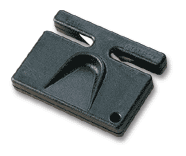
Price guide around £4.00 ($6). Cheap and it works very well on smaller knives but not as versatile as some of the systems shown above. You pays your money and you takes your choice! Manufacturer: Lansky Lansky diamond sharpening setDiamond Sharpening Set
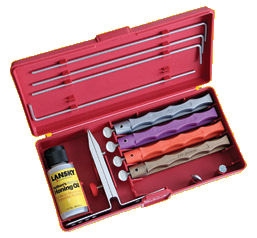
The Lansky Diamond deluxe sharpening set is expensive because of the diamond stones and you need to have many knives to sharpen to justify owning one. Price around £55.00 ($87) for the professional set.
They also produce a cheaper set with hones of Alumina Oxide and Ceramic Hones (roughly half the price).
Tips: No sharpening system is 100% accurate and although the set provides sufficient guide rods to set up each hone, better results are obtained by using the same guide rod for all the hones when working down the grades.
Also, more consistent results may be achieved by removing the knife from the flip-over knife clamp and turning it over (using the same side for both sides of the blade) rather than flipping the stand over and using the other side of it.
To achieve excellent results it is worth adding an Ultra–fine hone, a Super Sapphire hone and a Leather Stopping hone to your kit to achieve a highly polished and durable cutting edge. If you have a serrated knife you will also need medium and fine serrated hones.
The downsides:
- I found the system difficult to use without a bench stand, which can be purchased as an optional extra.
- The clamping system is not very efficient. In the instructions, it tells you to tighten it with a coin but I had to use a substantial screwdriver. You have to be very careful that a blade 10 – 15 cm (4 – 6 inches) doesn’t slip when sharpening it.
- For small blades, such as the Gerber L.S.T knife, it is very difficult to get the clamp to hold the blade. I tried it on several small knives and they were all difficult to hold in the clamp. It can be done, but I would not like to try it in minus degrees in a survival situation.
- The need to use oil makes the job messy. If you can clean yourself up afterwards — OK, but in the field, you are left with oily, black hands.
The positives:
- Once set up securely, the correct angles are easily achieved using the guide rods in the appropriate holes. The course diamond stone can easily re–edge a ruined blade even one made of high quality, hardened steel.
- Working down the grades of stone from course to fine gives a correctly angled and sharp cutting edge.
- The Sapphire stone (optional extra but worth the money) gives a highly polished edge with no burr.
Tip:
Do not use too much pressure when sharpening the blade. If you press too hard, you take off a lot of metal and the blade has a tendency to jump out of the clamp or move around. Too much pressure, especially as you work down the grades of abrasive leaves unnecessary grinding marks that that are hard work to remove with the sapphire stone. You need to find the right touch; it requires patience and a little finesse.
Overall: It works but is pricey and cheaper systems will do an equally good job. This sharpening system is really for use in the workshop to get your blades in first–class shape. In the field it is sufficient to carry the knife guide, one guide rod and the fine stone with you to keep a blade in top order. If you have a sapphire stone take that along too. Manufacturer: GATCO
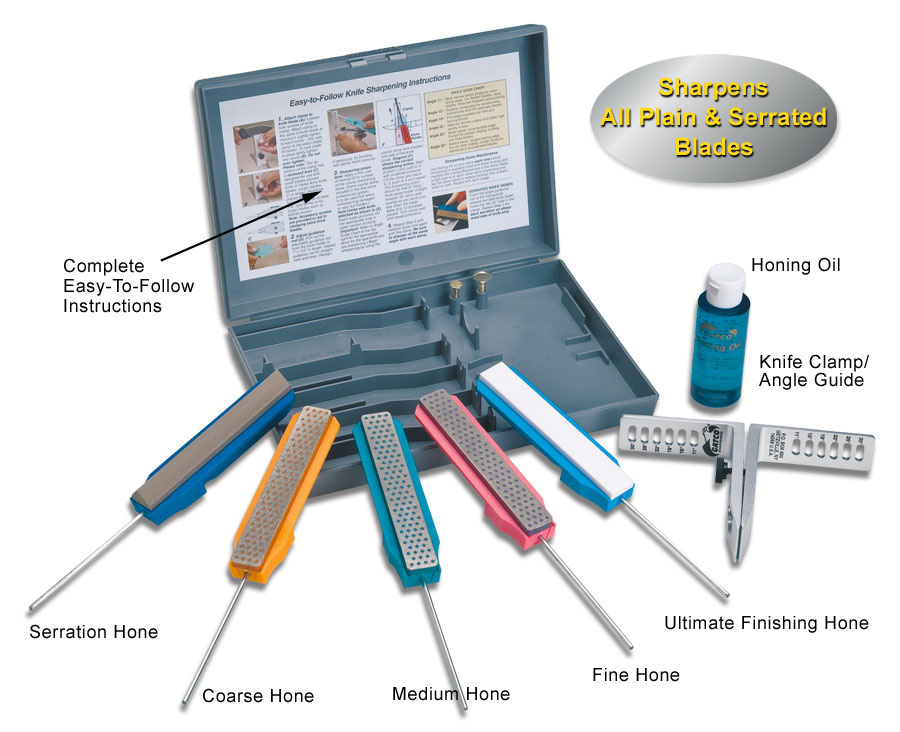
This sharpening kit is very similar to the Lansky kit and works the same way.
THIS SYSTEM CONTAINS:
- GATCO exclusive six–angle knife clamp/angle guide, ensures a precision honing action.
- Coarse monocrystalline diamond hone.
- Medium monocrystalline diamond hone.
- Fine monocrystalline diamond hone.
- 1200 grit ceramic finishing hone, for the ultimate finish edge.
- Special serrated knife hone.
- 0.6 decilitres (2 ounces) of honing oil meeting standards for safety with food contact.
- Custom case with easy to follow instructions permanently affixed to lid
Has one advantage over the Lansky kit in that the honing guide rods are attached to the grinding stones and pull out to the required length. This makes the hones more compact to carry in the field. The kit includes a hone for serrated blades. Not as well made as the Lansky kit but this is reflected in the price – see note below.
Tip: The rods are prone to get loose and wobble ruining the effectiveness of the sharpener. Apply some cyanoacrylate glue on the rods, then slid the rods in a couple of centimeters (an inch or so). This forces the glue into the wobbly slots. Let the glue cure and then brake the rods free from the glue by twisting them with pliers. Once broken free, the rods still slide in and out nicely, but no more wobble, restoring the effectiveness of the honing angle.
Price: around £37.99, circa $60.00. An extra fine sharpening hone will cost you an additional £7.99, circa $12.50. A useful addition is the GATCO Easy Clamp Mount which will add a further £5.99, circa $9.00.
For price and performance this is a highly recommended sharpening system.
Manufacturer: Darex LLC
Work Sharp Guided Field Sharpener The Guided Field Sharpener incorporates five stages of sharpening and honing, each with built in angle guides:
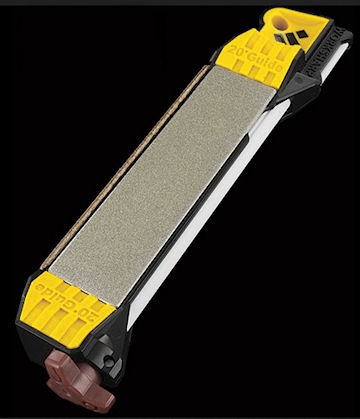
- 2 Diamond Plates: 1 coarse grit for shaping and repairing, and 1 fine grit for sharpening with 20° guides;
- two Ceramic Rods: a 3–position ceramic rod incorporating coarse grit and fine grit with 25° guides. A fish hook honing side, plus a smaller diameter, fine grit, serration sharpener;
- one Leather Strop conditioned with a micro-abrasive.
The sharpening guides for the diamond plates are fixed at 20° and on the ceramic rods at 25°. This makes the sharpener suitable for knives used for fine work, such as, skinning knives, pocket knives and filleting knives, but less attractive for knives requiring a more durable 25° edge.
Our product test We found the sharpener needed a little practice to get the best out of it, which is fair enough. The 20° honing guides assist in starting out the honing process, but you still have to maintain this angle as you move the blade away from the guide down the length of the blade.
Before you start, mark the edge with a marker pen (Sharpie) so you can see how well you are maintaining the angle of cut and adjust your cutting accordingly. With practice, it is possible to achieve a consistent angle along the length of the blade.
We found the sharpener works very well for flat and curved blades but is less successful for serrated blades and thick blades such tactical folders and knives with a Tanto shape as the design of this blade can radically affect the angle of honing if you use the 20° honing guide.
The diamond plates are easily removed (held by magnets, watch your compass, they throw out a strong magnetic field!) and this gives flexibility for freehand, un–guided sharpening of, for example, axes, hatchets and machetes.
We found the “fine” diamond plate is a bit course and to remove the grind marks with the ceramics is a little time consuming. The leather honing strop is a good addition and works well once you have patiently worked through the course and fine ceramic rods.
The grooved ceramic rod performs well for sharpening fish hooks and the fine grit serration sharpener works OK but is no substitute for a tapered file made for the job.
In summary, good for knives that require a 20° edge and with a little care and a lot of practice the sharpener works well and incorporates a lot of flexibility in how you can use it. Not bad for one device. Well made and easy to use. The 25° guided ceramic rods and leather strop make it a useful tool for touching up a pre–sharpened blade.
The course grit diamond plate takes off a lot of metal fast so do not start off with it, this is best suited to sharpening blades where the edge angle and blade profile is not so critical (such as, an axe blade or machete). The fine grit diamond plate is also quite abrasive so care is needed when using it (depending on the hardness of the blade steel), use minimum pressure and test out a few light strokes first. Price: £30.32 (Amazon UK) $29.75 in the USA. The Work Sharp Guided Field Sharpener is robust, has a lot of flexibility and is good value for money.

He has many years experience in difficult terrain, notably the Amazon, the African bush and climbing in various mountain regions including the Drakensburg Mountains and the Andes.
Outdoor Revival – Reconnecting you to the outdoors





